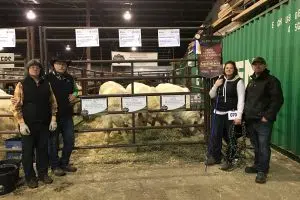Unlike many, ranchers don’t have the opportunity to take a snow day when the weather turns frigid — especially during calving season.
With around 250 Charolais calves to bring into the world over two months, Hodgeville area rancher Garner Deobald said there are no days off.
Over his 40-year ranching career, he said he’s learned the weather is just part of the industry, and it doesn’t stop him from doing what he loves.
“You have to be prepared from some hard work — that’s the way we choose to make a living,” Deobald said.

Lori and Garner Deobald (left), and Kylie and Brian Hawkins (right) of Cedarlea Farms pose for a picture with their prize Charolais cattle at the Canadian Western Agribition in Regina in November 2018. (Garner Deobald/Submitted)
Part of that hard work, he said, is checking his cattle every 45 minutes to an hour, 24 hours a day.
“You’ve got to be making sure that there aren’t any newborns and making sure that if there are any cows calving that we get them into one of the barns as quick as we can,” Deobald explained.
He noted the key to calving in the cold is having the proper infrastructure in place, like hot boxes, once the calves are born.
Before and after, Deobald said it all simmers down to making sure the cows have lots of straw bedding, shelter from the wind and enough nutrition.
And while it might be tough for some to believe, he added, there’s actually an advantage to calving when it’s cold: it cuts down on the spread of disease.
“As long as you can reduce the stress on (the cows) and keep that on a manageable level, it’s actually a good time of year for them health-wise,” Deobald explained.
When it comes to keeping warm outdoors, sometimes for hours at a time, he said dressing in layers is important; however, you tend to forget it’s -38 C when you’re busy working.
“That’s the nature of this business. No one is forcing us to do it, we choose to do it,” Deobald said.
Ever wonder what calves are like soon after they’re born? Here’s a great (adorable) video from Hodgeville, #Sask. area rancher Garner Deobald, who’s in the middle of #calving right now. #SaskAg pic.twitter.com/6qoCqxEquu
— Jessie Anton (@jessieanton_) February 8, 2019







